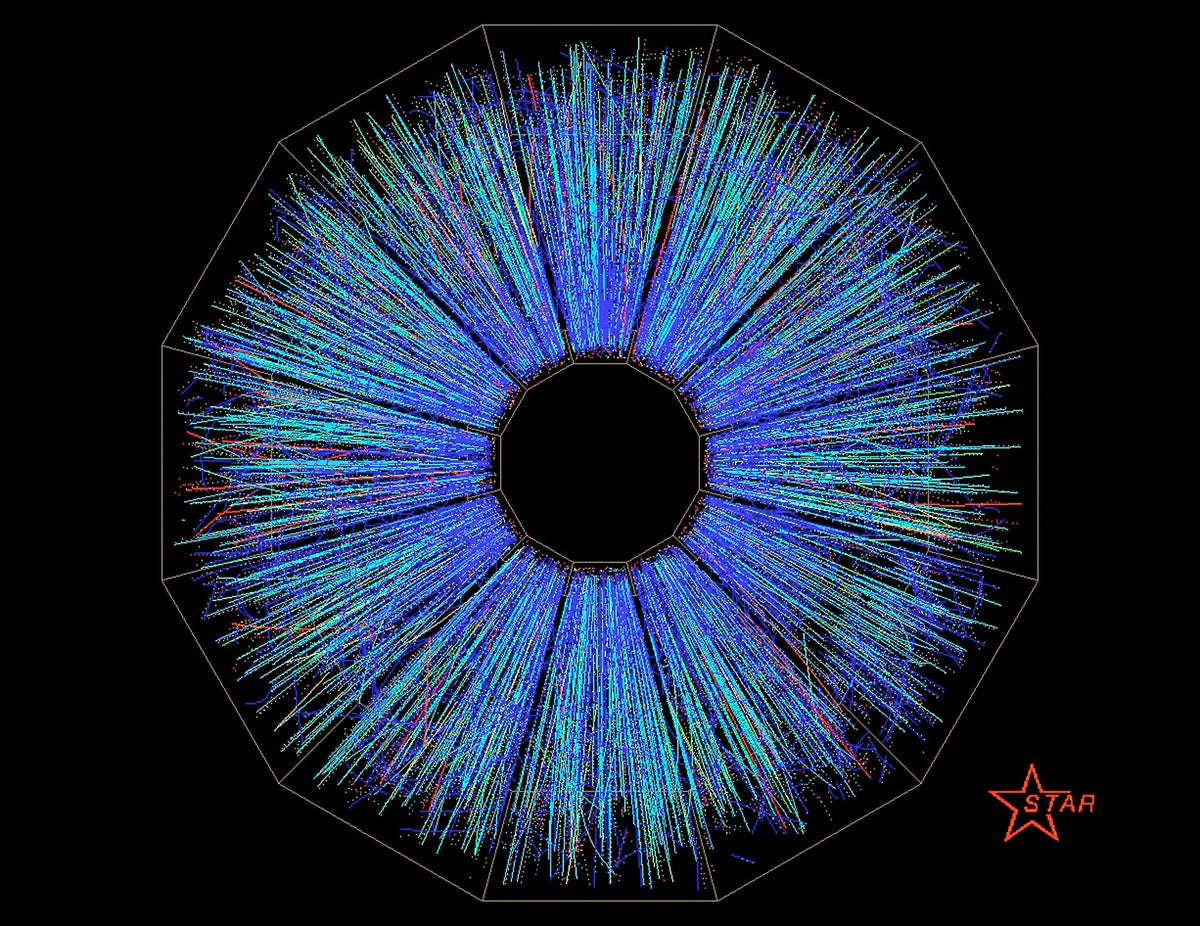Scientists Measure the Temperature of the Universe Just after the Big Bang
Quark-gluon plasma, a bizarre state of matter that mimics the early cosmos, is the hottest thing ever made on Earth
Image of two gold beams colliding at near the speed of light June 14, 2000. The collision took place at the Relativistic Heavy Ion Collider (RHIC) run by Brookhaven National Labratory in Brookhaven, NY.
Join Our Community of Science Lovers!
For the past quarter-century, scientists using a particle collider on Long Island have been smashing the nuclei of gold atoms together at nearly the speed of light to create the hottest matter ever made on Earth. The soup of particles born from the collision mimics the universe as it was just after the big bang. Now researchers have at last accurately measured the temperature of this matter for the first time.
After the gold nuclei crashed, the protons and neutrons within them melted into a seething cloud of quark-gluon plasma. This inferno re-creates conditions from the dawn of time, when the universe was too hot and dense to form regular atoms—or even their ingredients such as protons and neutrons. Instead the primordial cosmic soup would have been a blazing mess of the fundamental particles called quarks, as well as gluons, which carry the strong force that binds atomic nuclei together. “These are the building blocks of the particles that make up the visible world, and we’re trying to figure out how they work,” says physicist Zhangbu Xu of Brookhaven National Laboratory and Kent State University.
The experiment took place at Brookhaven National Laboratory’s Relativistic Heavy Ion Collider (RHIC), within the STAR (Solenoidal Tracker at RHIC) detector. There, gold nuclei racing along a 2.4-mile loop reach mind-boggling speeds before they bang together and disintegrate into quark-gluon plasma. Each primordial cloud lasts for only a split second, churning out many particles as it cools, including photons (particles of light) that decay into pairs of electrons and their antimatter counterparts, positrons.
If you’re enjoying this article, consider supporting our award-winning journalism by subscribing. By purchasing a subscription you are helping to ensure the future of impactful stories about the discoveries and ideas shaping our world today.
Physicists measured the mass ranges of such particle pairs to gauge the energy of the photons that birthed them, which in turn showed the temperature at which the photons were emitted. This revealed that temperature to be an astonishing 3.3 trillion degrees Celsius (5.94 trillion degrees Fahrenheit)—roughly 220,000 times hotter than the core of the sun. The scientists reported their results in Nature Communications.
Determining this temperature will help physicists figure out when and how the fiery primeval universe transitioned from quark -gluon plasma to the building blocks of atoms. These two states are different phases of matter, akin to the more familiar solid, liquid and gas phases of everyday life. “We want to map out what you could call the most fundamental ‘phase diagram’ that we know of,” says Frank Geurts of Rice University, a spokesperson for STAR. “What could be more interesting than the phase diagram of the fundamental building blocks of the universe?”
The RHIC accelerator and its STAR experiment are in the final stages of their last run, after starting up 25 years ago. The machines will shut down in the next few months to make way for a larger facility called the Electron-Ion Collider, which is due to open in the early 2030s. Even after STAR closes, however, scientists will analyze its last batch of data over the next few years to further hone their measure of this original cosmic fire.
Clara Moskowitz is chief of reporters at Scientific American, where she covers astronomy, space, physics and mathematics. She has been at Scientific American for more than a decade; previously she worked at Space.com. Moskowitz has reported live from rocket launches, space shuttle liftoffs and landings, suborbital spaceflight training, mountaintop observatories, and more. She has a bachelor’s degree in astronomy and physics from Wesleyan University and a graduate degree in science communication from the University of California, Santa Cruz.
If you enjoyed this article, I’d like to ask for your support. Scientific American has served as an advocate for science and industry for 180 years, and right now may be the most critical moment in that two-century history.
I’ve been a Scientific American subscriber since I was 12 years old, and it helped shape the way I look at the world. SciAm always educates and delights me, and inspires a sense of awe for our vast, beautiful universe. I hope it does that for you, too.
If you , you help ensure that our coverage is centered on meaningful research and discovery; that we have the resources to report on the decisions that threaten labs across the U.S.; and that we support both budding and working scientists at a time when the value of science itself too often goes unrecognized.
In return, you get essential news, captivating podcasts, brilliant infographics, , must-watch videos, challenging games, and the science world’s best writing and reporting. You can even gift someone a subscription.
There has never been a more important time for us to stand up and show why science matters. I hope you’ll support us in that mission.
Thank you,
David M. Ewalt, Editor in Chief, Scientific American
Source: www.scientificamerican.com
